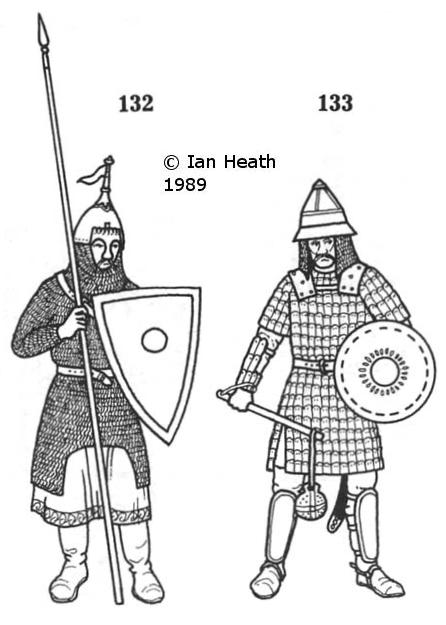
RUSSIAN CAVALRYMEN, 13th CENTURY
An extract from Armies of Feudal Europe 1066-1300by Ian Heath

132 & 133. RUSSIAN CAVALRYMEN, 13th CENTURY
Following continuous warfare with Pechenegs, Cumans and other nomadic tribes, culminating in the Mongol conquest of 1240, it was inevitable that Russia should ultimately enter the sphere of Eastern rather than Western military influence, and many features of the equipment worn by these figures is indicative of that influence. Since the Russians were extremely conservative the older types of equipment described under 131 also remained in use, particularly among the poorer nobility, but longer mail corselets such as that worn by 132 became predominant during the 13th century. The panel cut out at front and back was designed to assist riding. His almond shield has been adapted by the substitution of a straight top, possibly an isolated indication of Western influence. An optional shield introduced during this century was the small buckler carried by 133, constructed of two layers of interwoven osiers covered in silk or leather, elaborately painted and with a metal boss. The old almond shield also remained in service and is to be seen in many 14th and 15th century sources. 132's helmet is of a type which was also popular in the 12th century, often worn by officers with the colour of the small pennon perhaps indicating the unit. On some examples the nasal curves outward at the end so that the aventail or mail hood could be hooked up to it, leaving only the eyes exposed.
Lamellar, which had never entirely disappeared in Russia, underwent a revival in the 13th century and was especially popular amongst the wealthier boyars, remaining in common use right up to the 16th century. Russian lamellar corselets appear to have often been slit at the sides rather than the front and back, and that worn by 133 has in addition leather shoulder-pieces. The lamellae could be vertical or horizontal. The Asiatic ‘mirror’ armour described under 139 was also adopted. His brimmed helmet called a kapalin, is of Byzantine origin and could have a much taller point like that of 132. Alternatively a type very similar to the Western kettle-helmet could be worn. The Cuman and Pecheneg helmets described under 138 were also adopted, 138a being very popular amongst the wealthier boyars.
The weapon 133 carries is a kistien, a spherical or faceted metal head attached to a short handle by a leather thong, introduced from the East late in this period and popular for many centuries thereafter. His greaves and vambraces are also of Asiatic origin; these could be of plate or splint/lamellar construction. At least as early as the 11th century others wore boots, usually of dyed leather (mainly red, yellow or green), some with long, upturned toes.
Horses, of which 4 or 5 were taken on campaign (at least by princes), were sometimes equipped with Mongol-style horse-armour. This was generally either of several layers of leather, or of iron or leather lamellae. The chanfron at least was normally of metal. Horse colours favoured by the Russians were chestnut, bay, grey, black and white.